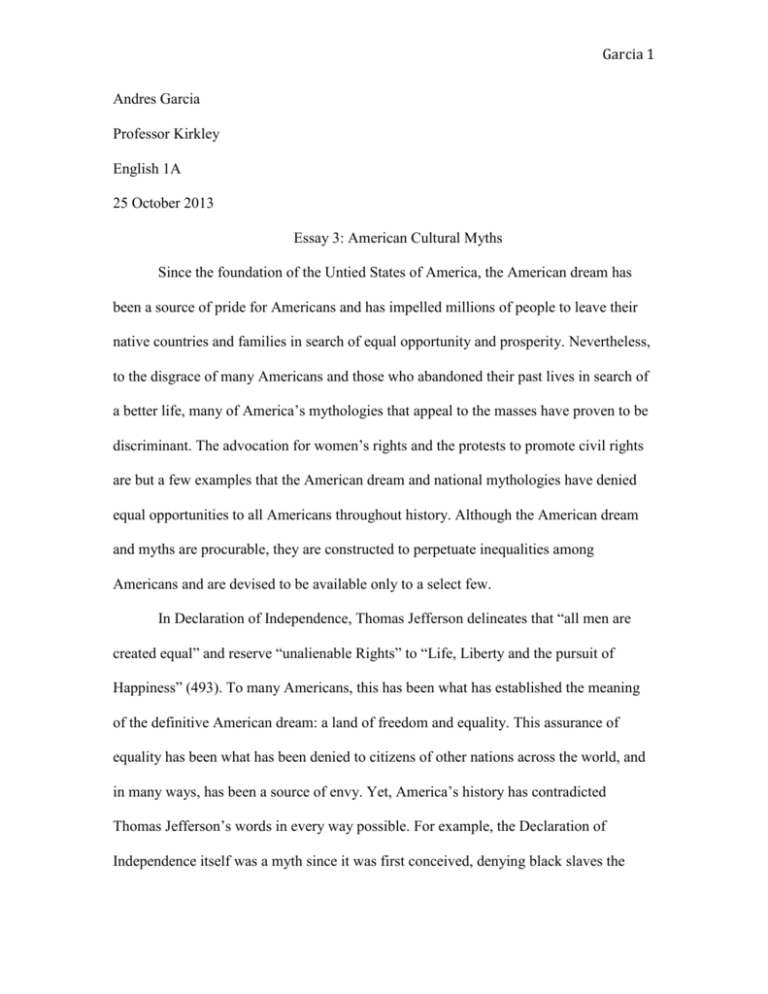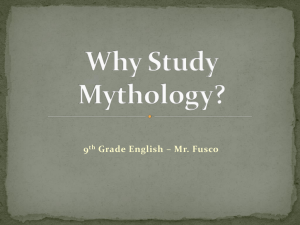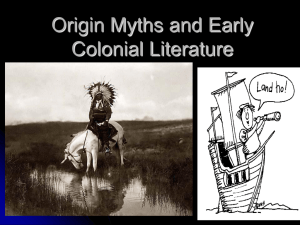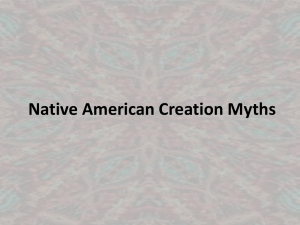File
advertisement

Garcia 1 Andres Garcia Professor Kirkley English 1A 25 October 2013 Essay 3: American Cultural Myths Since the foundation of the Untied States of America, the American dream has been a source of pride for Americans and has impelled millions of people to leave their native countries and families in search of equal opportunity and prosperity. Nevertheless, to the disgrace of many Americans and those who abandoned their past lives in search of a better life, many of America’s mythologies that appeal to the masses have proven to be discriminant. The advocation for women’s rights and the protests to promote civil rights are but a few examples that the American dream and national mythologies have denied equal opportunities to all Americans throughout history. Although the American dream and myths are procurable, they are constructed to perpetuate inequalities among Americans and are devised to be available only to a select few. In Declaration of Independence, Thomas Jefferson delineates that “all men are created equal” and reserve “unalienable Rights” to “Life, Liberty and the pursuit of Happiness” (493). To many Americans, this has been what has established the meaning of the definitive American dream: a land of freedom and equality. This assurance of equality has been what has been denied to citizens of other nations across the world, and in many ways, has been a source of envy. Yet, America’s history has contradicted Thomas Jefferson’s words in every way possible. For example, the Declaration of Independence itself was a myth since it was first conceived, denying black slaves the Garcia 2 unalienable rights mentioned. The hypocrisy could not be more evident; this declaration was an answer to the tyranny of King George III, yet the countless numbers of slaves in the colonies were facing oppression even greater than the colonists. What historically followed African-Americans included racial discrimination, segregation, and the inability to be able to enjoy the basic human rights that the Declaration of Independence grants the people of America. Evidently, after the countless efforts of protestors and advocates, the Civil Rights Act of 1963 legally prohibited the discrimination of African-Americans and all racial minorities. Although racial tensions in the United States have significantly decreased over the past couple of decades, freedom and equality continues to be a myth present day. Even after having undergone through protests to have the same rights and liberties that men possess, women in the United States today continue to face an inequality with earnings and salaries. The United States Department of Labor reported that in 2009, women made about 80 percent of their male opposites in the same fields (Bureau of Labor Statistics). This statistic demonstrates that women are clearly not meant to be created as equal as men, as it is implied in the Declaration of Independence. Furthermore, although interracial marriage has been legal in the United States for 46 years, homosexual and lesbian couples continue to be denied the freedom to legally marry. Many states continue to oppose gay marriage rights, and limit the freedom for such couples to pursue what they consider to be their pursuit of happiness. These realities that currently exist in modern American society indicate that the myth of equality that is so widely defended in the United States excludes many people. This exclusion is most prominently present within the United States’ congress. As the American population becomes increasingly diverse Garcia 3 every year, it would be rational to have equality in racial representation in the government; however, it is not the case. The very method in the election of congress representatives and senators is designed to be exclusionary. State legislators gerrymander districts in order to gain more votes for a particular political party, creating an uneven and unjust representation of the population. Perhaps one of the most known myths about American culture is that the United States is the “land of opportunity”. This belief has been one of the main motives for millions that have immigrated to America in search of what was not available to them in their own countries. Unfortunately, even for Americans, this myth is crafted to be exceptionally ostracizing. The American dream suggests that opportunity is available to anyone who seeks it; yet, in order to progress in American society, a solid education is generally necessary. Lower-income families and most immigrants are deprived of the opportunity to seek an education, whether it be the ignorance on how to achieve an education or not having the proper recourses that is necessary to have a complete education. This not only affects immigrants, but legal Americans as well. As David Brooks writes in his essay One Nation, Slightly Divisible, “assembly line workers [find] themselves competing against Third World workers who earn less than a dollar per hour” (532). In American culture, the myth of the United States being a “land of opportunity” is still very much relevant, though it is most easily available to the affluent. As a result of a limited education, it excludes lower-class children and a disadvantaged portion of the American population is the opportunity to obtain a solid education. Students who come from high-income classes have the desired opportunity that many want; yet it is not available for poorer populations in the United States. With access to the resources that Garcia 4 students need, wealthier students will be able to progress while the unavailability of such resources will impede impoverished students to succeed. America’s educational system is perhaps one of best examples of how America excludes certain groups. Education is often ignored when considering American myths of opportunity; however it is a critical matter to consider when discussing equal opportunity in America. To many countries across the world, the Untied States is widely seen as being the “city on the hill” where the “rugged individual” can thrive. Perhaps in the eyes of the outsider and even to some prideful Americans, it is indeed a these myths hold to be accountable for all Americans. And though these myths would not exist and be popular if others had not achieved them, they are especially discriminant to people who do not have the power to be masters of their own destinies. American contains many stories of hard work and reward, and the possibilities that this country extends to its citizens. Many immigrants who came to this country in search of better opportunities were successful in finding what they were looking for. However, despite the many success stories that make up America’s myths, the harsh reality is that it is not available to all who desire it. Most American myths are devised to be exclusively available to a privileged class of Americans, and it rare that such opportunities are given to underprivileged classes. It is not only a matter of money, but also a greater matter of social equality. Since the United States as founded, its principles have been contradicted and oppressed countless of Americans throughout history. People like to hear the success stories. No one wants to know the realities of the situation or know that this country also faces many of the same problems present in other countries (though perhaps America’s problems are generally dealt with in less violent ways). Garcia 5 In order for America’s national myths to continue being the way they are, it must exclude large portions of the population. America’s myths are surrounded with stories of victories, much of which come from the success in war. In order for there to be a victor, there must be failure on one side. America’s myths thrive on the defeated. It needs a weaker link in order for it to keep the strong and potent image that it has portrayed since its independence from the British Empire. America’s myths could not survive if they allow room for more people to take part on. For example, to keep the supremacy that is portrayed by being a “city on a hill”, it must be viewed in awe from the bottom. In addition, America runs on a capitalist system, which requires an impoverished population in order for it to remain stable. America, much like other countries, has its share of problems; however, if the American dream along with its myths is to survive, it will need to remain at the top, and will never be able to accommodate more people and retain the power that it holds. The American dream and myths would lose its exclusiveness and it’s yearning if it were to be available to anyone. Though the American dream and its myths are a reality, they are most easily accessed by the wealthy, and are not made available to the disadvantaged in a society that demands perfection out of its citizens. Garcia 6 Works Cited Jefferson, Thomas. “Declaration of Independence”. The Presence of Others: Voices and Images That Call Out for Response, 5th Edition. Eds. Andrea A. Lunsford and John J. Ruszkiewicz. Boston: Bedford/St. Martin’s, 2008. 492-495. Print. Brooks, David. “One Nation, Slightly Divisible”. The Presence of Others: Voices and Images That Call Out for Response, 5th Edition. Eds. Andrea A. Lunsford and John J. Ruszkiewicz. Boston: Bedford/St. Martin’s, 2008. 525-545. Print. Bureau of Labor Statistics, U.S. Department of Labor, The Editor’s Desk, Women’sto-men’s earnings ratio by age, 2009 on the Internet at http://www.bls.gov/opub/ted/2010/ted_20100708.htm.









